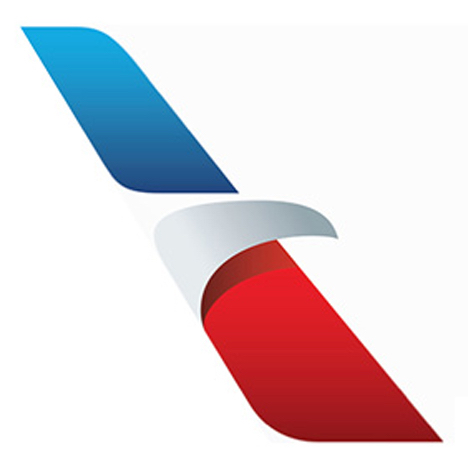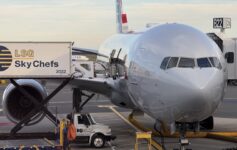American Airlines’ lawsuit against Expedia is not its only lawsuit currently pending. After being continually denied copyright protection for its logo pictured below, AA is taking the United States Copyright Office to court.
Yesterday I wrote about the difference between trademarks and copyrights. While American Airlines has successfully trademarked its logo, it has failed to secure copyright protection over it. Remember, a copyright protects “original works of authorship including literary, dramatic, musical, and artistic works, such as poetry, novels, movies, songs, computer software, and architecture.”

AA claims its logo, dubbed “the Flight Symbol,” blends unique elements, is easily recognizable, and thus warrants copyright protection. But regulators have taken a different view. As the Chicago Tribune reports:
But to the U.S. Copyright Office, the logo appears more like an “elongated rectangle” with an “exceedingly common” color palette of red, white and blue, lacking sufficient “original and creative” authorship to warrant protection.
The office has thrice denied American’s application for copyright protections that date back to 2016, prompting the Fort Worth-based carrier to file a federal lawsuit last week asking a judge to overrule the department’s decision, which American has called “arbitrary, capricious … and an abuse of discretion.”
You can read the 2018 ruling of the U.S Copyright Office here. But I will include a (rather long) snippet below, because it gets to the heart of why AA is feeling abused. The tone is frankly hilarious in its condescension.
Simply put, the Work is a dual-colored, curved trapezoid with a bisecting, shaded and curved triangle (i.e., roughly a “beak” shape). The Work thus is comprised of basic geometric shapes. As American acknowledges, copyright does not protect familiar shapes or designs, geometric shapes, or mere variations of coloring. 37 C.F.R. § 202. l(a). American asserts that when a work contains such basic shapes, the copyright in that work can be registered when the shape is transformed beyond its common character by modification, arrangement, or abstraction. American itself does not dispute that the Work consists of underlying geometric shapes, and although it criticizes the Office’s characterization of the Work’s shapes as containing “an elongated rectangle,” it describes the same design element of Work as “trapezoidal.” Neither insignificant variations in shape, coloring, nor word choice used to describe the Work change its character; trapezoids, rectangles, and triangles are all basic geometric shapes. Further, use of the colors of the United States flag (red, white, and blue) are exceedingly common and do not lend themselves to arguments that the Work’s design choices were especially creative. Finally, to the extent the Work evokes an airplane wing or bird design, that does not propel the design into the range of copyrightability. To the contrary, a very common design choice for an airline logo is to use the outline of a bird’s anatomy. See Birds of a feather flock together, LOGO DESIGN LOVE. In any event, even if a bird motif were unusual in this context, the Work falls below the threshold for creativity required by the Copyright Act.
The U.S. Supreme Court held in 1991 that copyright protection requires “a minimal degree of creativity”. Addressing this case, the U.S Copyright Office held that AA lacked even such a minimal degree of creativity:
The creative spark is utterly lacking or so trivial as to be virtually nonexistent…While the bar for creativity is low, it does exist and the Work cannot glide over even its low heights.
Ouch.
CONCLUSION
So now AA is suing. Like with Expedia, I expect AA to prevail. In any case, I’ll be following this case this closely.
> Read More: Why American Airlines Is Suing Expedia





This logo has grown on me over the years. It’s certainly identifiable and recognizable to the general public… At least I think it is. It doesn’t seem any less creative than a red triangle or a blue globe to me.
There are reasons that intellectual property rights differentiate between trademark and copyright. Now, what is AA’s agenda for pursuing copyright over trademarked logo?
You’d think they could use all that money being spent on legal fees to better train their workers to be more polite.
The trip that this USPTO employee took on American a few years back that was hassled at check-in, didn’t get his upgrade, sat on the runway for 3 hours, arrived hours late and kept getting banged into by the drink cart finally gets his revenge…
Agreed with everything until you said AA would prevail. Surprised that’s the conclusion without explanation. Most of the comments above seem more in-tuned.
IP gets so much protection it is a bit surprising this didn’t coast through the process but it’s really not creative. And I absolutely love the tone in the decisions… makes those casebooks less brutal when the court tries just an ounce of interesting.